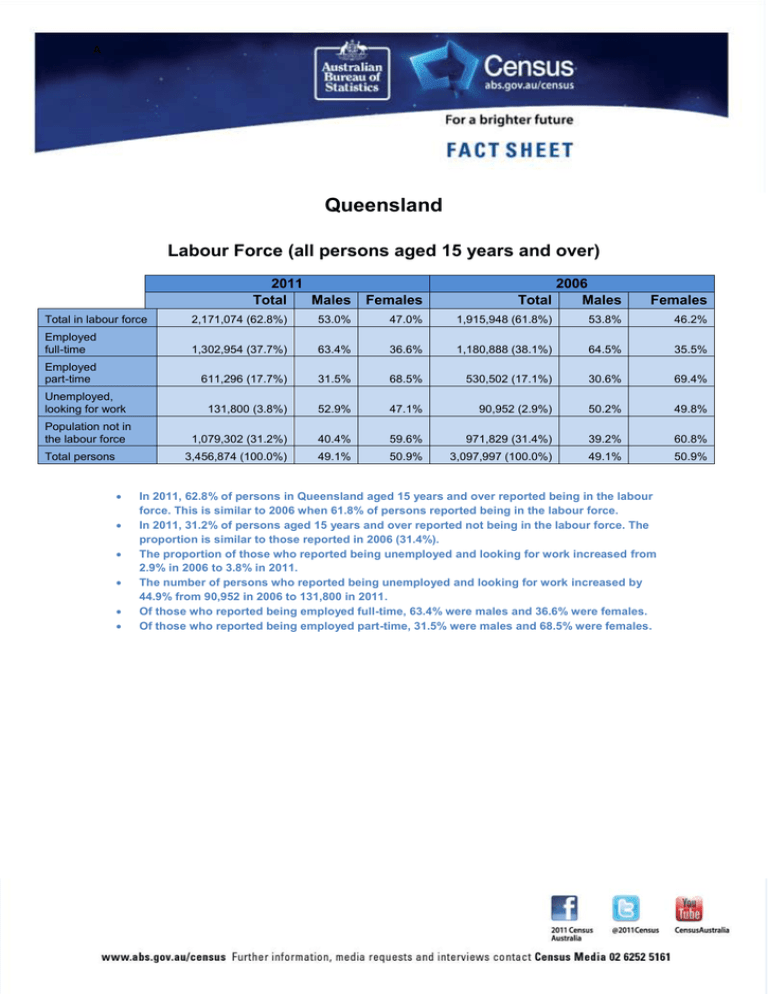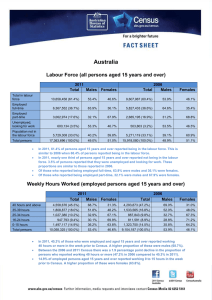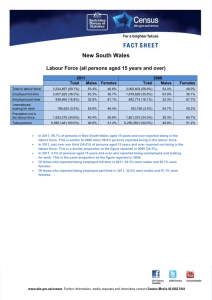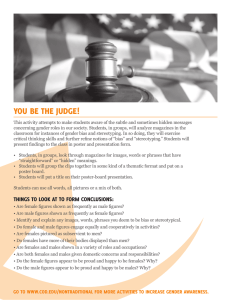Queensland Labour Force (all persons aged 15 years and over) A
advertisement

A Queensland Labour Force (all persons aged 15 years and over) 2011 Total Males Females 2006 Total Males Females Total in labour force 2,171,074 (62.8%) 53.0% 47.0% 1,915,948 (61.8%) 53.8% 46.2% Employed full-time 1,302,954 (37.7%) 63.4% 36.6% 1,180,888 (38.1%) 64.5% 35.5% Employed part-time 611,296 (17.7%) 31.5% 68.5% 530,502 (17.1%) 30.6% 69.4% 131,800 (3.8%) 52.9% 47.1% 90,952 (2.9%) 50.2% 49.8% 1,079,302 (31.2%) 40.4% 59.6% 971,829 (31.4%) 39.2% 60.8% 3,456,874 (100.0%) 49.1% 50.9% 3,097,997 (100.0%) 49.1% 50.9% Unemployed, looking for work Population not in the labour force Total persons In 2011, 62.8% of persons in Queensland aged 15 years and over reported being in the labour force. This is similar to 2006 when 61.8% of persons reported being in the labour force. In 2011, 31.2% of persons aged 15 years and over reported not being in the labour force. The proportion is similar to those reported in 2006 (31.4%). The proportion of those who reported being unemployed and looking for work increased from 2.9% in 2006 to 3.8% in 2011. The number of persons who reported being unemployed and looking for work increased by 44.9% from 90,952 in 2006 to 131,800 in 2011. Of those who reported being employed full-time, 63.4% were males and 36.6% were females. Of those who reported being employed part-time, 31.5% were males and 68.5% were females. A Queensland Weekly Hours Worked (employed persons aged 15 years and over) 2011 Total Males Females 2006 Total Males Females 40 hours and above 933,693 (45.8%) 68.9% 31.1% 873,162 (47.8%) 69.6% 30.4% 35-39 hours 369,262 (18.1%) 49.4% 50.6% 307,730 (16.9%) 49.9% 50.1% 25-34 hours 219,806 (10.8%) 32.2% 67.8% 190,554 (10.4%) 32.0% 68.0% 16-24 hours 179,615 (8.8%) 29.3% 70.7% 153,059 (8.4%) 27.8% 72.2% 292,268 (14.3%) 36.0% 64.0% 250,396 (13.7%) 35.6% 64.4% 2,039,275 (100.0%) 53.0% 47.0% 1,824,999 (100.0%) 53.9% 46.1% 0-15 hours Total persons In 2011, 45.8% of those in Queensland who were employed and aged 15 years and over reported working 40 hours or more in the week prior to the Census. A higher proportion of these were males (68.9%). Between the 2006 and 2011 Censuses there was a two percentage point decline in the proportion of persons who reported working 40 hours or more (47.8% in 2006 compared to 45.8% in 2011). In 2011, 14.3% of all employed persons aged 15 years and over reported working 0 to 15 hours in the week prior to the Census. A higher proportion of these were females (64.0%). A Queensland Top five industries in 2011 (employed persons aged 15 years and over) Health Care and Social Assistance Retail Trade Construction Manufacturing Education and Training Total persons Total 2011 Males Females Total 2006 Males Females 242,560 (11.9%) 217,610 (10.7%) 183,779 (9.0%) 171,668 (8.4%) 160,922 (7.9%) 2,039,275 (100.0%) 21.1% 40.7% 85.6% 75.6% 28.4% 53.0% 78.9% 59.3% 14.4% 24.4% 71.6% 47.0% 186,335 (10.2%) 212,422 (11.6%) 164,936 (9.0%) 180,212 (9.9%) 139,089 (7.6%) 1,824,999 (100.0%) 21.2% 41.9% 85.6% 75.9% 29.0% 53.9% 78.8% 58.1% 14.4% 24.1% 71.0% 46.1% In 2011, the largest proportion of employed persons aged 15 years and over reported working in the Health Care and Social Assistance industry (11.9%). In 2006, the Retail Trade industry was the most frequently reported response for employed persons aged 15 years and over (11.6%). The proportion of those who reported being employed in this industry declined to 10.7% in 2011, however there has been a minor increase in the number of persons employed in this industry (5,188 persons). The proportion of those who reported Manufacturing as their industry of employment has declined from 9.9% in 2006 to 8.4% in 2011. There has also been a decline in the number of persons who reported being employed in this industry (8,544 persons). In 2011, of those who reported working in the Manufacturing industry, 75.6% were males. In 2011, of those employed in the industries of Health Care and Social Assistance, Education and Training, and Retail Trade, a higher proportion were females (78.9%, 71.6% and 59.3% respectively). A Queensland Top five Occupations in 2011 (employed persons aged 15 years and over) 2011 Total Males Professionals Technicians and Trades Workers Clerical and Administrative Workers Managers Labourers Total persons Females Total 2006 Males Females 385,582 (18.9%) 44.7% 55.3% 312,869 (17.1%) 46.2% 53.8% 304,563 (14.9%) 85.8% 14.2% 280,340 (15.4%) 85.9% 14.1% 299,326 (14.7%) 245,605 (12.0%) 215,232 (10.6%) 2,039,275 (100.0%) 21.0% 63.4% 63.7% 53.0% 79.0% 36.6% 36.3% 47.0% 269,198 (14.8%) 225,693 (12.4%) 217,251 (11.9%) 1,824,999 (100.0%) 21.0% 64.3% 63.5% 53.9% 79.0% 35.7% 36.5% 46.1% In 2011, 18.9% of employed persons aged 15 years and over reported working as Professionals. Of those who reported working as Professionals, 55.3% were females. The proportion of employed persons aged 15 years and over who reported working as Professionals has increased by 1.8 percentage point to 18.9% in 2011 from 17.1% in 2006. The proportion of employed persons aged 15 years and over who reported working as Labourers declined (by 1.3 percentage point from 11.9% in 2006 to 10.6% in 2011. There was also a decline in the number of persons who reported working as Labourers (2,019 persons). There was a slight decline in the proportion of employed persons aged 15 years and over who reported working as Technicians and Trade Workers (from 15.4% in 2006 to 14.9% in 2011), but there was an increase in the number of persons who reported working in this occupation (24,223 persons). Of employed persons aged 15 years and over who reported working as Technicians and Trades Workers (14.9%), a higher proportion were males (85.8%). This compared to 14.7% of persons reporting as Clerical and Administrative workers, of whom 79.0% were females. A Queensland Highest Level of Education (all persons aged 15 years and over) 2011 Total Males Postgraduate Degree Graduate Diploma and Graduate Certificate Bachelor Degree Advanced Diploma and Diploma Females Total 2006 Males Females 94,645(100.0%) 53.1% 46.9% 60,399(1.9%) 56.3% 43.7% 49,477(1.4%) 36.1% 63.9% 36,177(1.2%) 37.2% 62.8% 404,771(11.7%) 42.1% 57.9% 309,327(10.0%) 42.9% 57.1% 260,780(7.5%) 41.7% 58.3% 204,041(6.6%) 42.7% 57.3% Certificate III/IV 589,002(17.0%) 70.6% 29.4% 471,771(15.2%) 74.5% 25.5% Year 12 614,440(17.8%) 45.9% 54.1% 538,796(17.4%) 45.8% 54.2% 1,026,518(29.7%) 43.3% 56.7% 1,041,162(33.6%) 42.6% 57.4% 3,456,874(100.0%) 49.1% 50.9% 3,097,997(100.0%) 49.1% 50.9% Year 11 or below (includes Certificate I/II/nfd) Total persons In 2011, there was a significant increase in number of persons who reported completing a Postgraduate Degree, from 60,399 in 2006 to 94,645 in 2011 (a 56.7% increase). There has also been a significant increase in the number of persons who reported completing a Graduate Diploma or Graduate Certificate as their highest level of education, from 36,177 in 2006 to 49,477 in 2011 (an increase of 36.8%). There was significant growth in persons who reported completing a Bachelor Degree as their highest level of education, from 309,327 in 2006 to 404,771 in 2011 (an increase of 30.9%). There has been a decline in the number of those who reported Year 11 and below (including Certificate level I/II) as their highest level of education, from 1,041,162 in 2006 to 1,026,518 in 2011. A higher proportion of those who reported their highest level of education as Graduate Diploma or Graduate Certificate, Bachelor Degree, and Advanced Diploma and Diploma were females (63.9%, 57.9% and 58.3% respectively).. Of those who reported completing Certificate III/IV as their highest level of education, a higher proportion were males (70.6%). A Queensland Top five Fields of Study in 2011 (all persons aged 15 years and over who stated a completed qualification) Engineering and Related Technologies Management and Commerce Society and Culture Health Education Total persons Total 2011 Males Females Total 2006 Males Females 314,630(16.8%) 310,801(16.6%) 180,558(9.6%) 173,990(9.3%) 139,977(7.5%) 1,875,324(100.0%) 94.4% 37.4% 31.1% 22.9% 23.5% 52.7% 5.6% 62.6% 68.9% 77.1% 76.5% 47.3% 269,402(17.3%) 228,738(14.7%) 128,353(8.2%) 131,993(8.5%) 119,072(7.6%) 1,560,869(100.0%) 94.8% 37.9% 33.1% 22.3% 24.6% 53.9% 5.2% 62.1% 66.9% 77.7% 75.4% 46.1% In 2011 Engineering and Related Technologies (16.8%) and Management and Commerce (16.6%) were the two most common fields of study completed reported by persons aged 15 years and over. These fields were also reported as the most common fields of study in the 2006 Census. Between the 2006 and 2011 Censuses there has been a decline in the proportion of those who reported Engineering and Related Technologies (0.5 percentage point) but a proportionate increase in those who reported Management and Commerce (1.9 percentage point). The number of those reporting these fields of study completed has increased between 2006 and 2011. Of those who reported Management and Commerce, and Society and Culture as their field of study, a higher proportion were females (62.6% and 68.9% respectively). Of those who reported Engineering and Related Technologies as their field of study a significantly higher proportion were males (94.4%). Over three quarters of those who reported Health and Education as their fields of study were females (77.1% and 76.5% respectively). A Queensland Top five Methods of Travel to Work in 2011 (employed persons aged 15 years and over) Car, as driver Car, as passenger Walked only Bus Train Total persons 2011 Total Persons 2006 Total Persons 1,248,541(61.2%) 125,270(6.1%) 75,561(3.7%) 67,192(3.3%) 42,800(2.1%) 2,039,275(100.0%) 1,090,011(59.7%) 123,256(6.8%) 72,983(4.0%) 52,270(2.9%) 36,036(2.0%) 1,824,999(100.0%) Transport by car continues to be the most commonly reported method of travel to work. Over two thirds (67.3%) of employed persons aged 15 years and over reported that they travelled to work by car (either as driver or a passenger) on 9 August 2011. The number of employed persons aged 15 years and over who walked to work has increased from 72,983 in 2006 to 75,561 in 2011; however, the proportion of persons who walked to work has declined from 4.0% in 2006 to 3.7% in 2011 (reflecting a slower rate of growth compared to other forms of travel). A Queensland Place of Usual Residence one year ago (all persons who moved, excluding persons aged under one year) 2011 2006 616,280 (80.6%) 610,133 (80.4%) Interstate 75,240 (9.8%) 83,007 (10.9%) Overseas 63,185 (8.3%) 57,581 (7.6%) 764,692 (100.0%) 759,132 (100.0%) Within State Total persons Of the Queensland residents who moved in the year prior to the 2011 Census, most moved within the State (80.6%). There were 63,185 (8.3%) of persons who had moved to Queensland from overseas in the year prior to the 2011 Census. Place of Usual Residence five years ago (all persons who moved, excluding persons aged under five years) 2011 2006 1,331,607 (73.4%) 1,292,142 (74.0%) Interstate 218,734 (12.1%) 259,885 (15.0%) Overseas 238,591 (13.1%) 159,539 (9.0%) 1,815,132 (100.0%) 1,734,698 (100.0%) Within State Total persons More than three quarters (73.4%) of the Queensland residents who moved five years prior to Census moved within the State. There were 238,591 (13.1%) of persons who had moved to Queensland from overseas in the five years prior to the 2011 Census.






